

高等学校化学学报 ›› 2024, Vol. 45 ›› Issue (9): 20240199.doi: 10.7503/cjcu20240199
侯泽金, 李荣其, 李健, 冯怡宁, 靳茜茜, 孙俊红, 曹洁( )
)
收稿日期:2024-04-19
出版日期:2024-09-10
发布日期:2024-05-31
通讯作者:
曹洁
E-mail:jie.cao@sxmu.edu.cn
基金资助:
HOU Zejin, LI Rongqi, LI Jian, FENG Yining, JIN Qianqian, SUN Junhong, CAO Jie( )
)
Received:2024-04-19
Online:2024-09-10
Published:2024-05-31
Contact:
CAO Jie
E-mail:jie.cao@sxmu.edu.cn
Supported by:摘要:
通过研究深静脉血栓形成(DVT)大鼠血液中内源性代谢物的变化规律筛选特征代谢物以此构建疾病预测模型, 用于DVT的临床诊断和法医学鉴定. 采用下腔静脉结扎法构建DVT大鼠模型, 术后72 h采集心血, 通过气相色谱-质谱法(GC-MS)分析得到大鼠血清中的小分子代谢谱. 通过正交偏最小二乘判别分析结合Mann-Whitney U检验初步筛选得到与DVT发生相关的22个差异代谢物, 涉及的体内代谢通路有乙醛酸和二羧酸代谢、 三羧酸循环(TCA循环)以及丙氨酸、 天冬氨酸和谷氨酸代谢. 采用基于随机森林分类算法的特征选择方法(Boruta)从上述差异代谢物中进一步筛选出13个与DVT强相关的特征代谢物集合, 构建了基于不同机器学习算法(逻辑回归、 线性判别分析和Adaboost集成算法)的DVT预测模型. 结果显示, 构建的线性判别分析模型对DVT的预测准确率可达87%, 模型的精度、 召回率、 F1分数和受试者特征曲线下面积(AUROC)分别为0.88, 0.86, 0.87和0.95. 研究表明, 采用GC-MS代谢组学结合机器学习算法构建的DVT预测模型可为DVT的诊断、 治疗以及法医学鉴定提供技术支撑.
中图分类号:
TrendMD:
侯泽金, 李荣其, 李健, 冯怡宁, 靳茜茜, 孙俊红, 曹洁. 基于GC-MS和机器学习的深静脉血栓形成预测. 高等学校化学学报, 2024, 45(9): 20240199.
HOU Zejin, LI Rongqi, LI Jian, FENG Yining, JIN Qianqian, SUN Junhong, CAO Jie. Prediction of Deep Vein Thrombosis Based on GC-MS and Machine Learning. Chem. J. Chinese Universities, 2024, 45(9): 20240199.
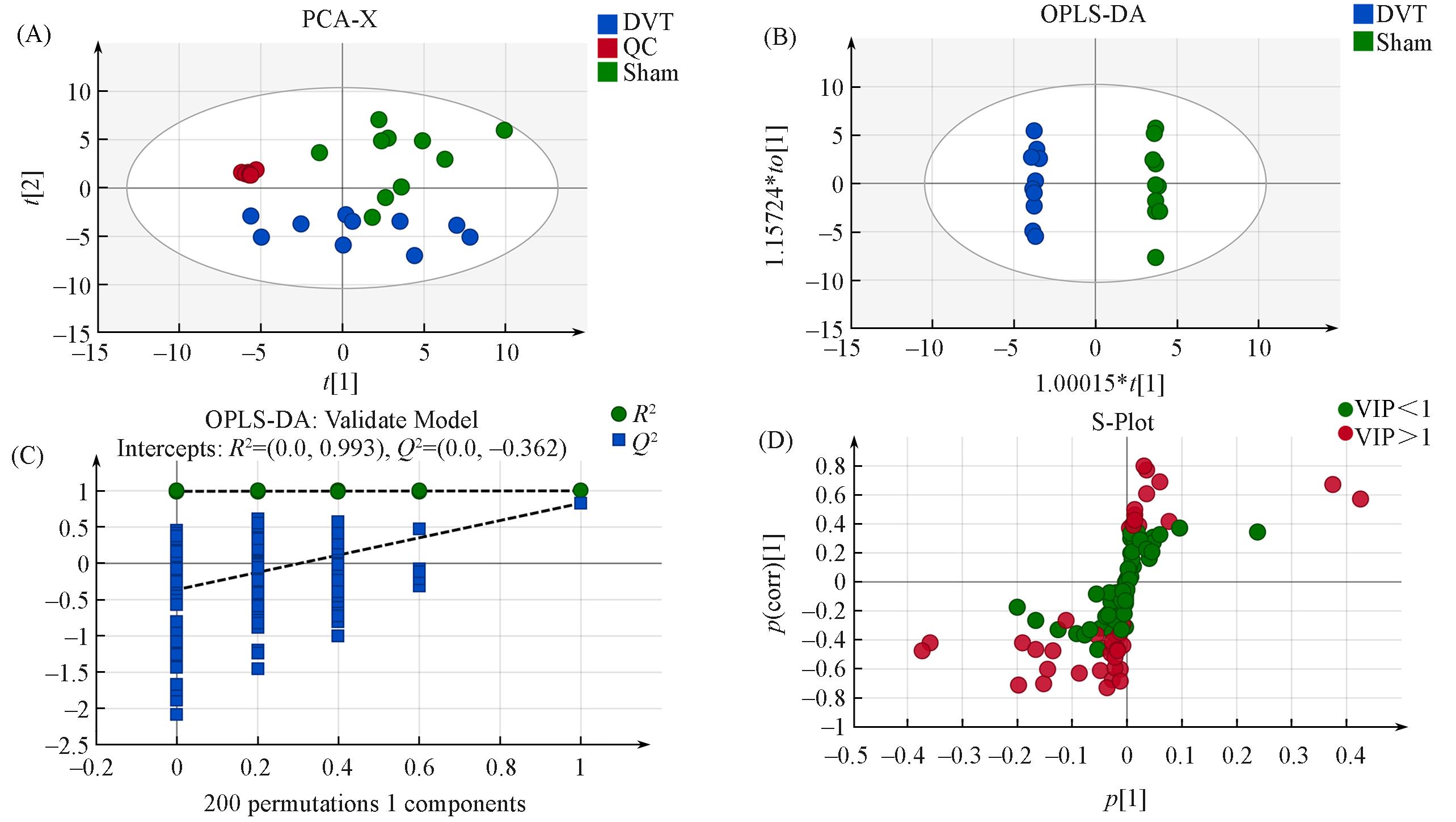
Fig.1 Multivariate statistical analysis of serum samples in DVT and sham rats(A) PCA scatter plot; (B) OPLS-DA scatter plot; (C) OPLS-DA permutation test plot; (D) S-plot of OPLS-DA.
| No. | Compound | Molecular formula | m/z | Retention time/min | Similarity | VIP | P value |
|---|---|---|---|---|---|---|---|
| 1 | 2⁃Aminoisobutyric acid | C4H9NO2 | 130.02 | 11.671 | 0.957 | 1.595 | 0.003 |
| 2 | Citric acid | C6H8O7 | 272.98 | 29.074 | 0.935 | 1.731 | <0.001 |
| 3 | Nicotinamide | C6H6N2O | 178.97 | 19.154 | 0.935 | 1.641 | <0.001 |
| 4 | 3⁃Methyl⁃2⁃oxovaleric acid | C6H10O3 | 89.04 | 11.802 | 0.935 | 1.396 | 0.010 |
| 5 | 3⁃Deoxytetronic acid | C4H8O4 | 117.02 | 15.240 | 0.957 | 1.425 | 0.003 |
| 6 | 3⁃Hydroxypropanoate | C3H6O3 | 146.99 | 11.077 | 0.957 | 1.474 | 0.008 |
| 7 | 5⁃Oxoproline | C5H7NO3 | 156.00 | 20.518 | 0.935 | 1.328 | 0.028 |
| 8 | D⁃Pinitol | C7H14O6 | 260.02 | 29.327 | 0.761 | 1.772 | <0.001 |
| 9 | L⁃Isoleucine | C6H13NO2 | 158.00 | 13.780 | 0.891 | 1.500 | 0.003 |
| 10 | L⁃Ornithine hydrochloride | C5H13ClN2O2 | 185.95 | 26.954 | 0.717 | 1.182 | 0.036 |
| 11 | L⁃Proline | C5H9NO2 | 142.00 | 14.289 | 0.935 | 1.294 | 0.021 |
| 12 | N⁃Acetyl⁃L⁃glutamate | C7H11NO5 | 185.99 | 19.805 | 0.935 | 1.404 | 0.011 |
| 13 | β⁃D⁃Glucose | C6H12O6 | 319.00 | 31.510 | 0.935 | 1.421 | 0.011 |
| 14 | Glycolate | C2H4O3 | 147.00 | 9.516 | 0.935 | 1.341 | 0.024 |
| 15 | Decanoic acid | C10H20O2 | 229.02 | 18.563 | 0.935 | 1.535 | 0.002 |
| No. | Compound | Molecular formula | m/z | Retention time/min | Similarity | VIP | P value |
| 16 | Glycerophosphoric acid | C3H9O6P | 356.97 | 27.377 | 0.935 | 1.448 | 0.002 |
| 17 | Isocitric acid | C6H8O7 | 245.03 | 29.212 | 0.913 | 1.602 | 0.001 |
| 18 | Suberic acid | C8H14O4 | 117.98 | 25.755 | 0.935 | 1.645 | <0.001 |
| 19 | Allose | C6H12O6 | 319.00 | 31.507 | 0.761 | 1.506 | 0.004 |
| 20 | 4⁃Chloropyridine⁃2,6⁃dicarboxylic Acid | C7H4ClNO4 | 258.97 | 38.004 | 0.935 | 1.219 | 0.026 |
| 21 | Conduritol⁃β⁃expoxide | C6H10O5 | 317.96 | 34.204 | 0.935 | 1.425 | 0.005 |
| 22 | Oxalacetic acid | C4H4O5 | 174.00 | 8.887 | 0.935 | 1.206 | 0.042 |
Table 1 22 Differential metabolites of the rat serum between DVT and Sham groups*
| No. | Compound | Molecular formula | m/z | Retention time/min | Similarity | VIP | P value |
|---|---|---|---|---|---|---|---|
| 1 | 2⁃Aminoisobutyric acid | C4H9NO2 | 130.02 | 11.671 | 0.957 | 1.595 | 0.003 |
| 2 | Citric acid | C6H8O7 | 272.98 | 29.074 | 0.935 | 1.731 | <0.001 |
| 3 | Nicotinamide | C6H6N2O | 178.97 | 19.154 | 0.935 | 1.641 | <0.001 |
| 4 | 3⁃Methyl⁃2⁃oxovaleric acid | C6H10O3 | 89.04 | 11.802 | 0.935 | 1.396 | 0.010 |
| 5 | 3⁃Deoxytetronic acid | C4H8O4 | 117.02 | 15.240 | 0.957 | 1.425 | 0.003 |
| 6 | 3⁃Hydroxypropanoate | C3H6O3 | 146.99 | 11.077 | 0.957 | 1.474 | 0.008 |
| 7 | 5⁃Oxoproline | C5H7NO3 | 156.00 | 20.518 | 0.935 | 1.328 | 0.028 |
| 8 | D⁃Pinitol | C7H14O6 | 260.02 | 29.327 | 0.761 | 1.772 | <0.001 |
| 9 | L⁃Isoleucine | C6H13NO2 | 158.00 | 13.780 | 0.891 | 1.500 | 0.003 |
| 10 | L⁃Ornithine hydrochloride | C5H13ClN2O2 | 185.95 | 26.954 | 0.717 | 1.182 | 0.036 |
| 11 | L⁃Proline | C5H9NO2 | 142.00 | 14.289 | 0.935 | 1.294 | 0.021 |
| 12 | N⁃Acetyl⁃L⁃glutamate | C7H11NO5 | 185.99 | 19.805 | 0.935 | 1.404 | 0.011 |
| 13 | β⁃D⁃Glucose | C6H12O6 | 319.00 | 31.510 | 0.935 | 1.421 | 0.011 |
| 14 | Glycolate | C2H4O3 | 147.00 | 9.516 | 0.935 | 1.341 | 0.024 |
| 15 | Decanoic acid | C10H20O2 | 229.02 | 18.563 | 0.935 | 1.535 | 0.002 |
| No. | Compound | Molecular formula | m/z | Retention time/min | Similarity | VIP | P value |
| 16 | Glycerophosphoric acid | C3H9O6P | 356.97 | 27.377 | 0.935 | 1.448 | 0.002 |
| 17 | Isocitric acid | C6H8O7 | 245.03 | 29.212 | 0.913 | 1.602 | 0.001 |
| 18 | Suberic acid | C8H14O4 | 117.98 | 25.755 | 0.935 | 1.645 | <0.001 |
| 19 | Allose | C6H12O6 | 319.00 | 31.507 | 0.761 | 1.506 | 0.004 |
| 20 | 4⁃Chloropyridine⁃2,6⁃dicarboxylic Acid | C7H4ClNO4 | 258.97 | 38.004 | 0.935 | 1.219 | 0.026 |
| 21 | Conduritol⁃β⁃expoxide | C6H10O5 | 317.96 | 34.204 | 0.935 | 1.425 | 0.005 |
| 22 | Oxalacetic acid | C4H4O5 | 174.00 | 8.887 | 0.935 | 1.206 | 0.042 |
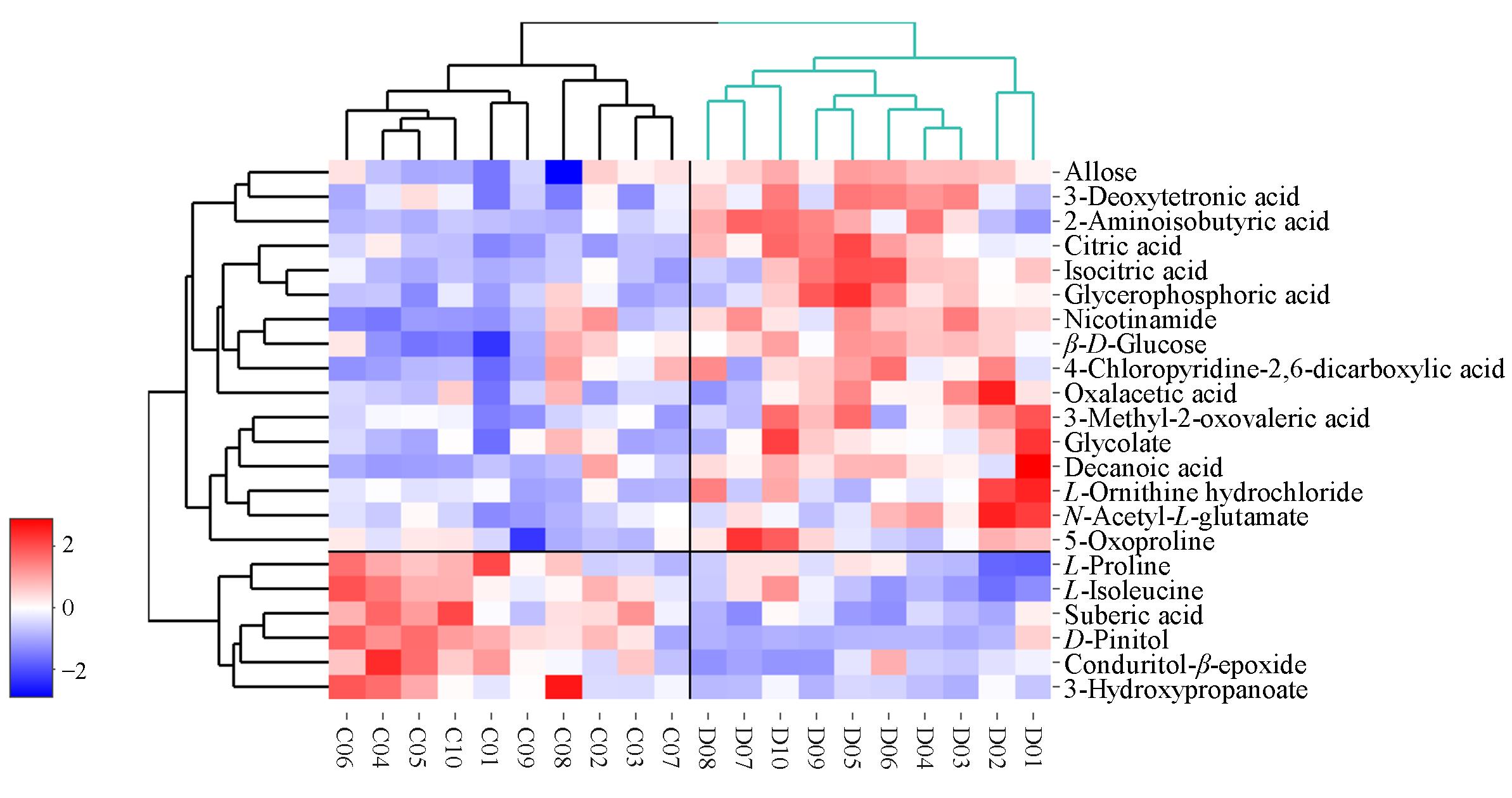
Fig.2 Clustering heatmap of the 22 differential metabolites between DVT and sham groupsThe abscissa represents the DVT group(D01—D10) and Sham group(C01—C10) samples, and the ordinate represents 22 differentially metabolites. Red boxes represent high levels of metabolites and blue boxes represent low levels.
| Pathway name | Total | Hits | P value | Impact |
|---|---|---|---|---|
| Glyoxylate and dicarboxylate metabolism | 32 | 4 | 0.00013 | 0.13493 |
| Citrate cycle (TCA cycle) | 20 | 3 | 0.000612 | 0.25318 |
| Alanine, aspartate and glutamate metabolism | 28 | 2 | 0.025050 | 0.09135 |
Table 2 DVT metabolic pathway analysis results
| Pathway name | Total | Hits | P value | Impact |
|---|---|---|---|---|
| Glyoxylate and dicarboxylate metabolism | 32 | 4 | 0.00013 | 0.13493 |
| Citrate cycle (TCA cycle) | 20 | 3 | 0.000612 | 0.25318 |
| Alanine, aspartate and glutamate metabolism | 28 | 2 | 0.025050 | 0.09135 |
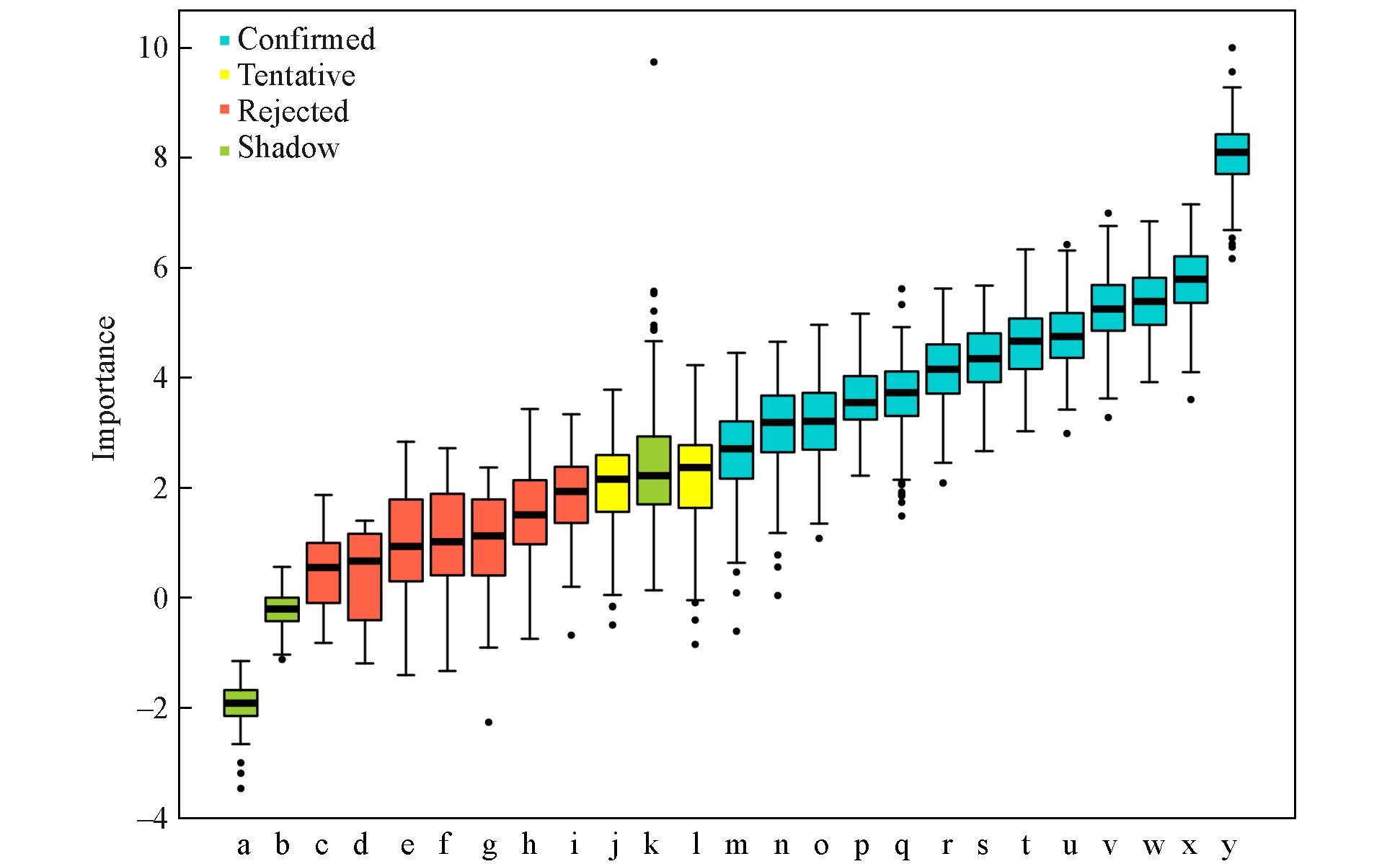
Fig.4 Box plot of differential metabolites′ order obtained by Boruta feature selectiona. ShadowMin; b. shadowMean; c. glycolate; d. 4⁃chlcropyridine⁃2,6⁃dicarboxylic acid; e. L⁃ornithine hydrochloride; f. oxalacetic acid; g. β⁃D⁃glucose; h. 5⁃oxoproline; i. 3⁃deoxytetronic acid; j. L⁃proline; k. shadowMax; l. N⁃acetyl⁃L⁃glutamate; m. conduritol⁃β⁃Expoxide; n. allose; o. glycerophosphoric acid; p. L⁃isoleucine; g. 3⁃methyl⁃2⁃oxovaleric acid; r. 2⁃aminoisobutyric acid; s. isocitric acid; t. suberic acid; u. nicotinamide; v. 3⁃hydroxypropanoate; w. D⁃pinitol; x. decanoic acid; y. citric acid.
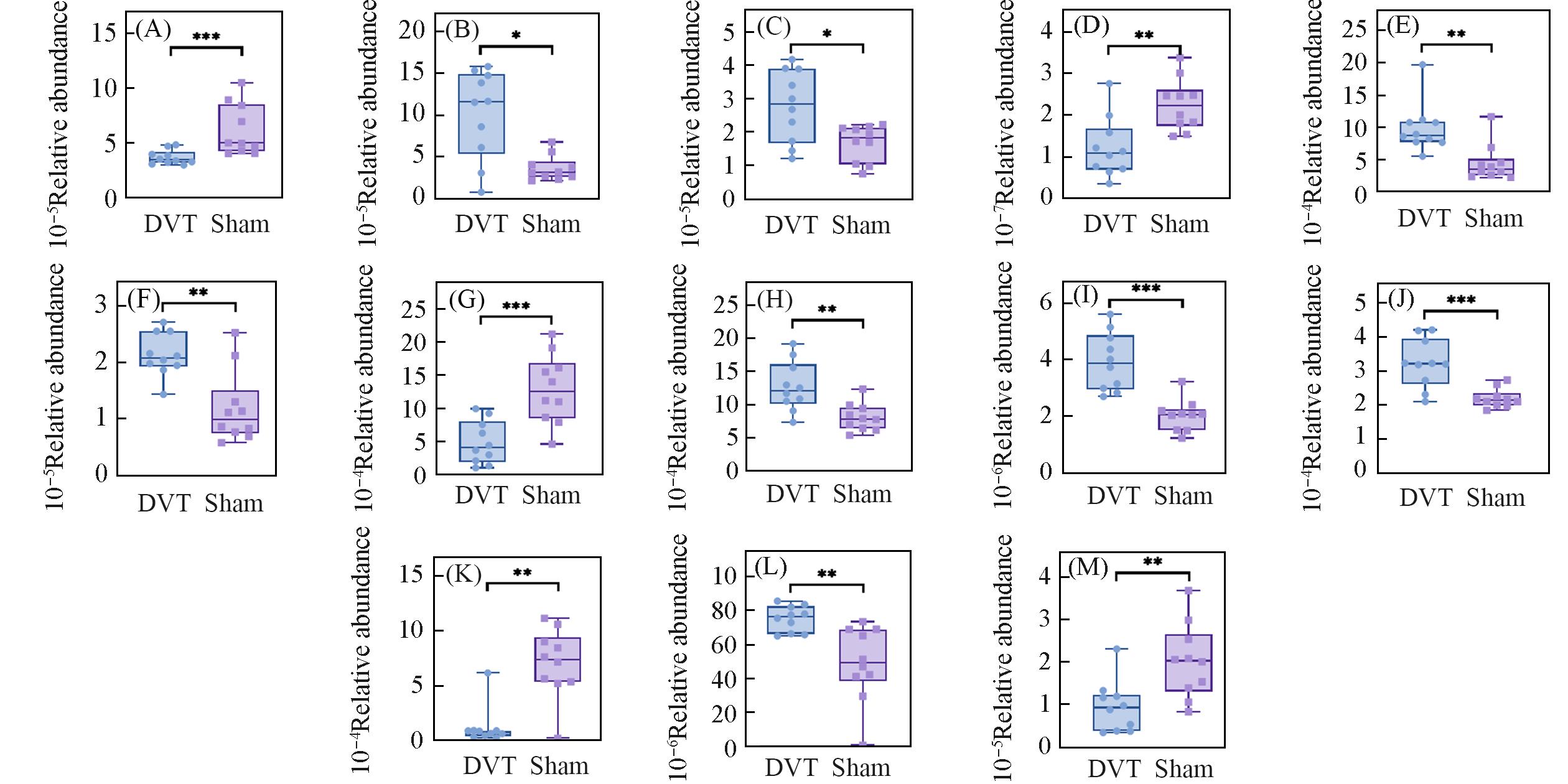
Fig.5 Relative levels of 13 differential metabolites in DVT and sham operation groups*P <0.05, **P <0.01, ***P <0.001. DVT; Sham.(A) 3⁃Hydroxypropanoate; (B) 2⁃aminoisobutyric acid; (C) 3⁃methyl⁃2⁃oxovaleric acid; (D) L⁃isoleucine; (E) decanoic acid; (F) nicotinamide; (G) suberic acid; (H) glycerophosphoric acid; (I) citric acid; (J) isocitric acid; (K) D⁃pinitol; (L) allose; (M) conduritol⁃β⁃expoxide.
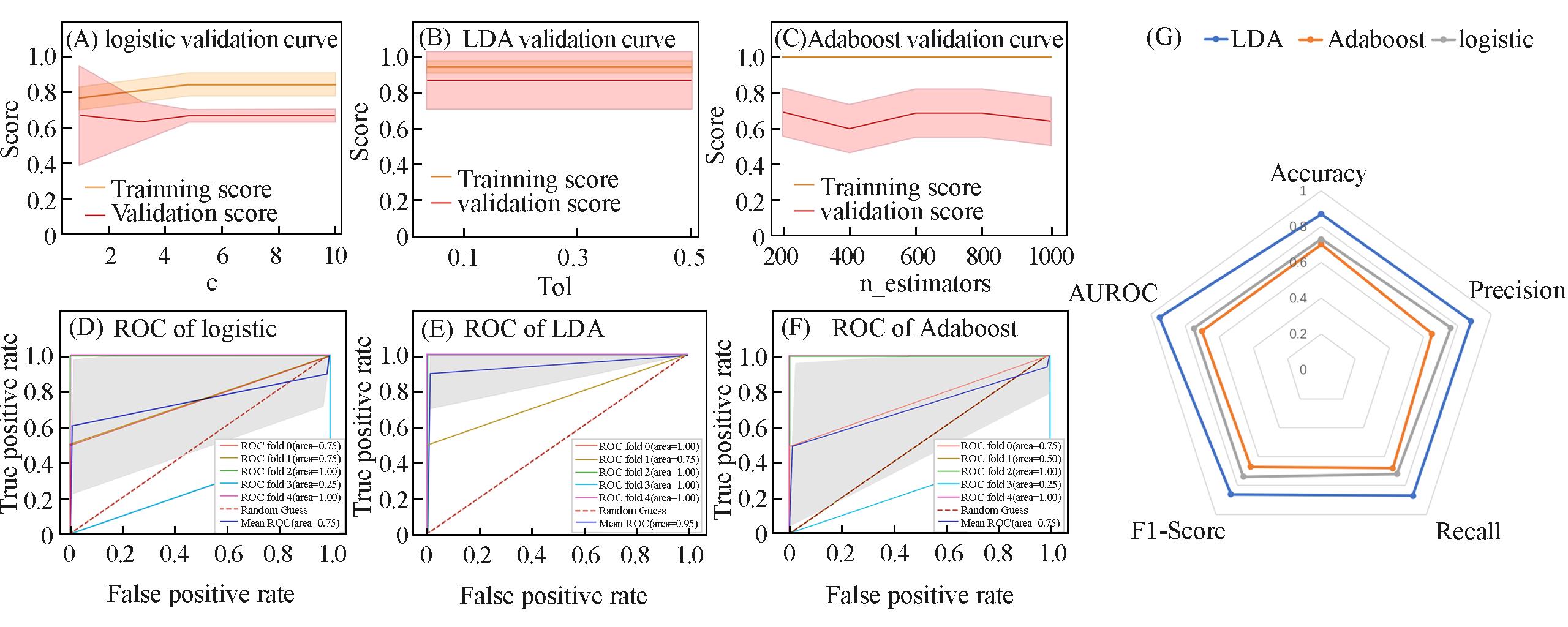
Fig.6 Predicted results of machine learning models(A)—(C) Validation curves of LR, LDA and Adaboost, respectively; (D)—(E) ROC curves of LR, LDA and Adaboost, respectively; (G) comparison of the results of three prediction models. The validation curve shows the relationship between model hyperparameters and accuracy. The abscissa represents the model hyperparameters, while the ordinate represents the model accuracy. The yellow line represents the trend of training set accuracy changes with hyperparameter variation, and the yellow shadow represents the standard deviation of training set accuracy. The red line represents the trend of validation set accuracy changes with hyperparameter variation, and the red shadow represents the standard deviation of validation set accuracy.
| 1 | Raskob G. E., Angchaisuksiri P., Blanco A. N., Buller H., Gallus A., Hunt B. J., Hylek E. M., Kakkar A., Konstantinides S. V., McCumber M., Ozaki Y., Wendelboe A., Weitz J. I., Arterioscler. Thromb. Vasc. Biol., 2014, 34(11), 2363—2371 |
| 2 | Liu Y. L., Zhao Y. J., Zhang G. H., Chinese J. Forensic Medicine, 2016, 31(4), 424—426 |
| 刘玉利, 赵一杰, 张国徽. 中国法医学杂志, 2016, 31(4), 424—426 | |
| 3 | Sung Y., Spagou K., Kafeza M., Kyriakides M., Dharmarajah B., Shalhoub J., Diaz J. A., Wakefield T. W., Holmes E., Davies A. H., Eur. J. Vasc. Endovasc. Surg., 2018, 55(5), 703—713 |
| 4 | Li X. Q., Zhang F. X., Wang S. M., Chinese Journal of Vascular Surgery(Electronic Version), 2017, 9(4), 250—257 |
| 李晓强, 张福先, 王深明. 中国血管外科杂志(电子版), 2017, 9(4), 250—257 | |
| 5 | Di Nisio M., Squizzato A., Rutjes A. W., Büller H. R., Zwinderman A. H., Bossuyt P. M., J. Thromb. Haemost., 2007, 5(2), 296—304 |
| 6 | Stroup B. M., Nair N., Murali S. G., Broniowska K., Rohr F., Levy H. L., Ney D. M., J. Nutr., 2018, 148(2), 194—201 |
| 7 | Taegtmeyer H., Circulation, 2016, 134(4), 265—266 |
| 8 | Sun J., Modern Chemical Research, 2017, (9), 4—5 |
| 孙静. 当代化工研究, 2017, (9), 4—5 | |
| 9 | Mizuno H., Ueda K., Kobayashi Y., Tsuyama N., Todoroki K., Min J. Z., Toyo'oka T., Biomed. Chromatogr., 2017, 31(1), e3864 |
| 10 | Guan T., Xin Y., Zheng K., Wang R. J., Zhang X., Jia S. Q., Li S. Q., Cao C., Zhao X. J., Biometals, 2021, 34(1), 33—48 |
| 11 | Tan B. B., Zhang Y., Zhang T. T., He J. S., Luo X. Y., Bian X. Q., Wu J. L., Zou C., Wang Y. Z., Fu L., Biomed. Chromatogr., 2020, 34(10), e4922 |
| 12 | Yang B. Y., Li X. L., Yao Y., Wang C., Chen S. N., Wu X. J., Wu D. P., J. Exp. Hematol., 2017, 25(6), 1585—1591 |
| 杨冰玉, 李晓莉, 姚遥, 王畅, 陈苏宁, 吴小津, 吴德沛. 中国实验血液学杂志, 2017, 25(6), 1585—1591 | |
| 13 | Liebal U. W., Phan A. N. T., Sudhakar M., Raman K., Blank L. M., Metabolites, 2020, 10(6), 243 |
| 14 | Wang W. Y., He Z. R., Kong Y., Liu Z. Q., Gong L. Z., Clin. Chim. Acta, 2021, 519, 10—17 |
| 15 | Baiges⁃Gaya G., Iftimie S., Castañé H., Rodríguez⁃Tomàs E., Jiménez⁃Franco A., López⁃Azcona A. F., Castro A., Camps J., Joven J., Biomolecules, 2023, 13(1), 163 |
| 16 | Jin Q. Q., Sun J. H., Du Q. X., Lu X. J., Zhu X. Y., Fan H. L., Hölscher C., Wang Y. Y., Int. J. Mol. Med., 2017, 40(4), 1019—1028 |
| 17 | Fan S., Kind T., Cajka T., Hazen S. L., Tang W. H. W., Kaddurah⁃Daouk R., Irvin M. R., Arnett D. K., Barupal D. K., Fiehn O., Anal. Chem., 2019, 91(5), 3590—3596 |
| 18 | Cao J., Lv X. G., Li Y., Jin Q. Q., Chu X. Y., Wang Y. Y., Sun J. H., J. Forensic Med., 2018, 34(3), 228—232 |
| 曹洁, 吕晓革, 李宇, 靳茜茜, 储晓云, 王英元, 孙俊红. 法医学杂志, 2018, 34(3), 228—232 | |
| 19 | Pan H., Exploring the Formation Mechanism of Deep Vein Thrombosis of Lower Extremities Based on Multi⁃omics Technology, Jilin University, Changchun, 2021 |
| 潘赫. 基于多组学技术探讨下肢深静脉血栓的形成机制, 长春: 吉林大学, 2021 | |
| 20 | Zhou Y. S., Qu J. L., Han Y. L., Chin. J. Cell Biol., 2023, 45(3), 428—435 |
| 周悦思, 曲家良, 韩英伦. 中国细胞生物学学报, 2023, 45(3), 428—435 | |
| 21 | Branchford B. R., Carpenter S. L., Front. Pediatr., 2018, 6, 142 |
| 22 | Kursa M. B., Rudnicki W. R., J. Stat. Softw., 2010, 36(11), 1—13 |
| 23 | Nian Y., Su X. X., Yue H., Zhu Y. J., Li J., Wang W. Q., Sheng Y. L., Ma Q., Liu J. K., Li X. W., Front. Plant Sci., 2024, 15, 1396183 |
| [1] | 张妍, 蒋行健, 刘明, 郑植, 张勇. 基于分子性能与器件制备的低泛化误差有机太阳电池光电转化效率预测模型[J]. 高等学校化学学报, 2023, 44(7): 20230165. |
| [2] | 黄汉浩, 卢湫阳, 孙明子, 黄勃龙. 石墨炔原子催化剂的崭新道路:基于自验证机器学习方法的筛选策略[J]. 高等学校化学学报, 2022, 43(5): 20220042. |
| [3] | 杜嘉辉, 廖康, 洪本坤, 王钟烨, 马晶, 李伟, 黎书华. 普适的基于能量的分块局域激发态聚类算法[J]. 高等学校化学学报, 2021, 42(7): 2227. |
| [4] | 张楠茜, 吕经纬, 金平, 李晶峰, 边学峰, 张辉, 孙佳明. N-苄基十六碳酰胺促小鼠Leydig细胞增殖和分泌睾酮的 1H NMR代谢组学研究[J]. 高等学校化学学报, 2019, 40(9): 1832. |
| [5] | 王毅, 张苹, 吴生秀, 孙媛媛, 赵彤, 刘世熙. 质谱中反偶电子规则并含双电荷离子的两类联苯化合物的裂解机理[J]. 高等学校化学学报, 2018, 39(3): 435. |
| [6] | 李雯雯, 朱爱如, 龙怡静, 王春燕, 韩源平, 段忆翔. 高脂与维生素D缺乏饮食诱导的2型糖尿病小鼠血清和肝脏代谢组学研究[J]. 高等学校化学学报, 2018, 39(11): 2395. |
| [7] | 黄玉, 谷彩云, 吴翰钟, 夏晓爽, 李新. 基于超高效液相色谱-四极杆飞行时间质谱的缺血性脑卒中的代谢组学研究[J]. 高等学校化学学报, 2017, 38(10): 1742. |
| [8] | 王曦烨, 单晓彤, 王伊林, 李丹, 赵明, 许良. 丹参多酚酸盐改善扩张性心肌病心肌功能的作用机制[J]. 高等学校化学学报, 2016, 37(5): 844. |
| [9] | 李鹏辉, 邓伶莉, 罗娇, 李巍, 宁晶, 丁健桦, 邬小萍. 多批次肝衰竭患者呼出气体的电喷雾萃取电离质谱检测及代谢组学数据分析[J]. 高等学校化学学报, 2016, 37(4): 626. |
| [10] | 杨永霞, 王琳琳, 郑凌云, 王淑美, 黄榕波, 张磊, 黄耀庭. 基于核磁共振氢谱代谢组学研究黄连解毒汤对胰岛素抵抗大鼠棕色脂肪组织代谢组的影响[J]. 高等学校化学学报, 2014, 35(9): 1883. |
| [11] | 张瑞兴, 刘舒, 皮子凤, 宋凤瑞, 刘志强. 汞离子对细胞代谢通路影响的代谢组学[J]. 高等学校化学学报, 2014, 35(6): 1146. |
| [12] | 梅桢, 蔡文生, 邵学广. 免疫算法用于复杂样品的GC-MS快速分析[J]. 高等学校化学学报, 2013, 34(4): 819. |
| [13] | 黄敏, 高建义, 翟志刚, 梁琼麟, 王义明, 白延强, 罗国安. 基于药代动力学和代谢组学研究咖啡因对异丙嗪镇静作用的影响[J]. 高等学校化学学报, 2013, 34(4): 829. |
| [14] | 成玉, 刘玉敏, 黄凤杰, 陈天璐, 郑晓皎, 赵爱华, 何品刚, 贾伟. 基于超高效液相色谱-四极杆飞行时间高分辨质谱的高通量血清代谢组学方法[J]. 高等学校化学学报, 2013, 34(1): 77. |
| [15] | 牛俊, 皮子凤, 越皓, 刘淑莹. 格列美脲治疗的2型糖尿病大鼠的尿液代谢组学研究[J]. 高等学校化学学报, 2012, 33(10): 2169. |
| 阅读次数 | ||||||
|
全文 |
|
|||||
|
摘要 |
|
|||||